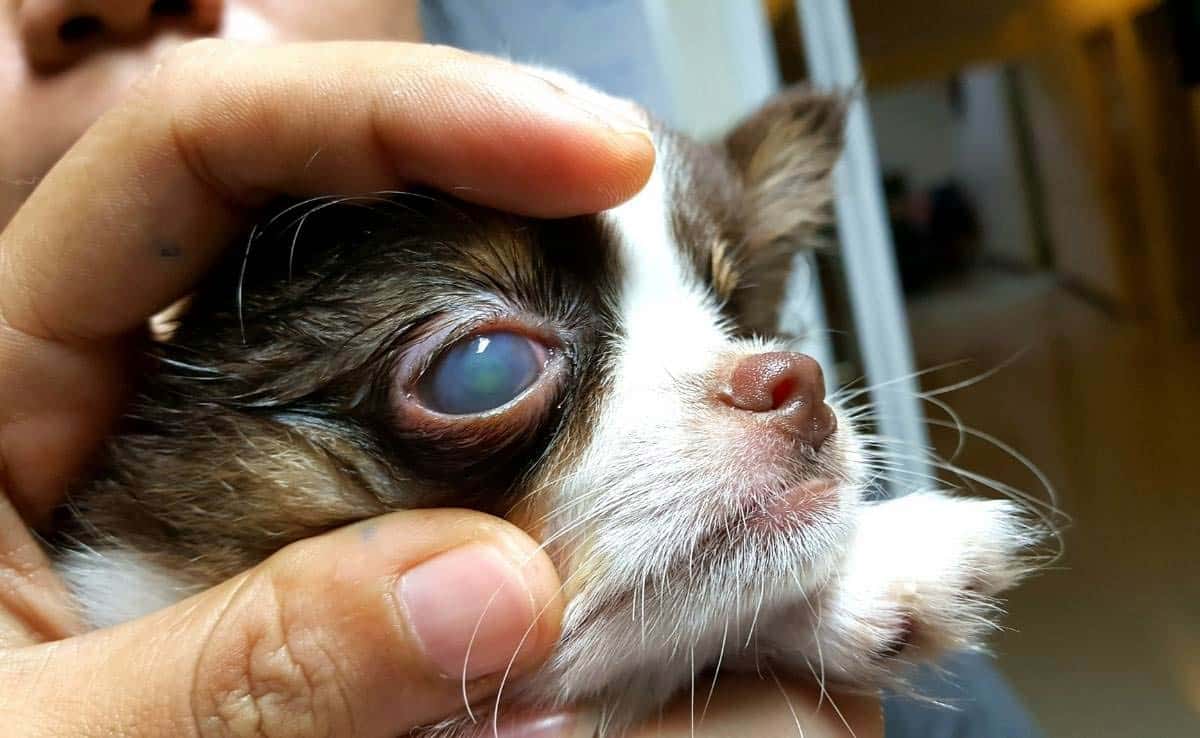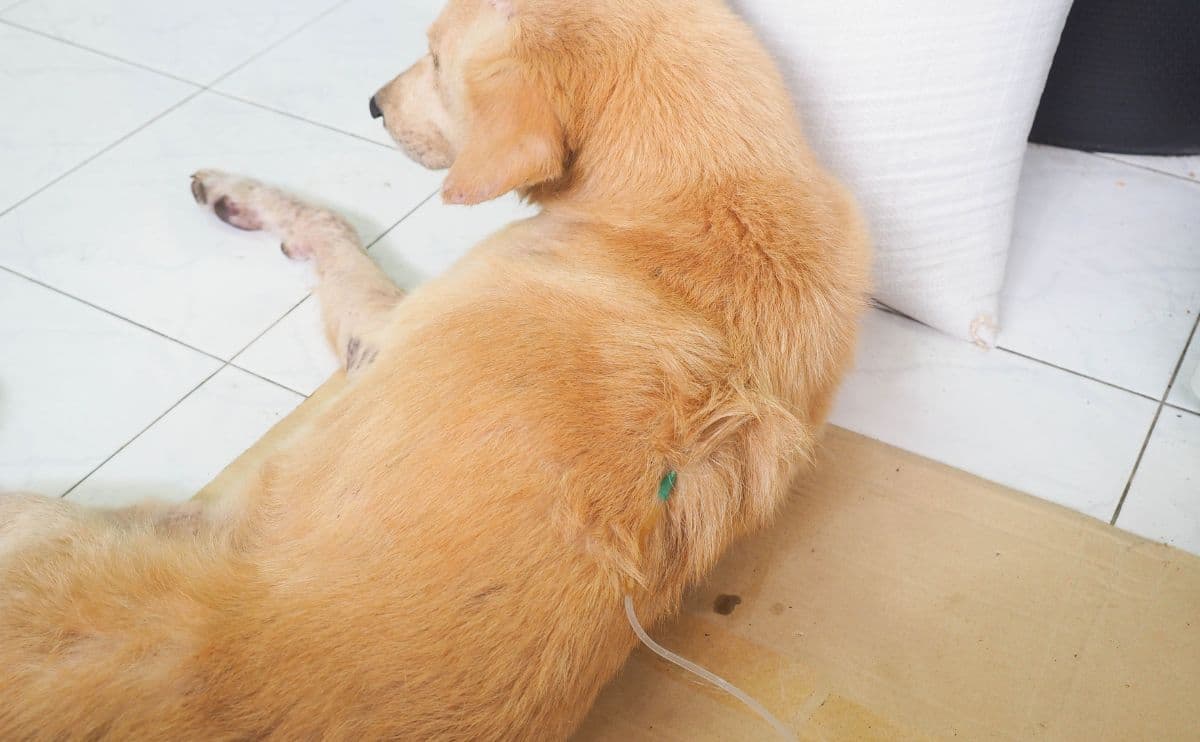When you purchase through links on our site, we may earn a commission. Here’s how it works.

Does your dog have red, watery eyes? Are they irritated? If so, it could indicate that your dog has an allergy. Because our dog’s eyes are precious, it’s essential to know what to do.
Eye irritation, discharge, or redness in your pup’s eyes is abnormal. These symptoms can be caused by many conditions and are all reasons to see your veterinarian, but specifically related to allergies, these can point to allergic conjunctivitis. So how do you tell the difference? And what do you do if your dog has an eye allergy?
What Is Conjunctivitis?
Conjunctivitis, or pinkeye, is the swelling of the pink flesh (conjunctiva) around your dog’s eye. The eyelids usually cover and protect it. You can check the conjunctiva by gently separating your pooch’s eyelids. If your pup has conjunctivitis, the flesh of the eye will be red and swollen, and they may have discharge from one or both eyes. Common causes of conjunctivitis are bacteria, viruses, irritants (such as cleaning products or smoke), and allergies.
What Causes Allergic Conjunctivitis In Dogs?
There can be many causes of allergic conjunctivitis in dogs. Sometimes we can’t always tell what they are. But, most often, they are caused by something in the environment (in the house or outside) or food.
Common Environmental Causes
- House dust mites
- Storage mites
- Pollen
- House dust
- Mould
- Bacteria & yeast
- Parasites or insects
Your dog can also have a sudden allergic reaction to insect bites, especially bees or wasps.
Possible Food Causes
- Meat proteins (e.g., chicken, beef)
- Egg
- Cereals
- Dairy
What Are Symptoms Of Dog Eye Allergies?
- Watery eyes
- Red eyes
- Discharge (usually grey, milky mucus)
- Excessive blinking
- Swollen skin around the eyes
- Hair loss around the eyes
- Rubbing the eyes
- Thin white/pink film over the eye (third eyelid)
Other Symptoms Of Allergies In Dogs
If your dog has allergic conjunctivitis, they may also have skin problems such as hair loss, spots, or itchy skin or feet.
Allergies or reactions to bee or wasp stings are also common in dogs. Bites or stings on the face or mouth can cause sudden swelling around your pooch’s eyes. The eyes can also be watery and red, like with other allergies.
You should call the vet immediately to get treatment, as this can progress to breathing problems in some dogs.

How Are Eye Allergies Diagnosed In Dogs?
Finding out the cause of your pup’s eye problem requires visiting the vet clinic. First, your veterinarian will ask you questions, e.g., when did it start? Where were they? What does your dog eat? Where do they sleep/play? But also will look at their age, breed, and whether they have had eye problems before.
Next, an eye exam will identify where the problem is. Tests to rule out severe conditions may be needed, such as eye pressure (for glaucoma) or dye placed in the eye (for trauma). If conjunctivitis is diagnosed, a swab can check for viruses or bacteria. If these are negative, your dog may have allergic conjunctivitis.
A body examination can identify if your dog has skin problems, which may increase their suspicion of allergic conjunctivitis. However, skin problems can have many causes — your veterinarian may want to perform a blood test or skin test to look for allergies. They might also recommend a food trial where your dog avoids certain foods to see if their symptoms get better.
What Dog Eye Allergy Treatment Will The Vet Give My Dog?
There are many available treatments for eye conditions and allergies. It depends on how badly your pup is affected and what is causing the problem.
- Anti-inflammatory eye drops
- Anti-histamine tablets
- Antibiotics (if an infection or ulcer is diagnosed)
- Painkillers
What Dog Allergy Eye Drops Are Available?
Allergy eye drops for dogs are used to relieve the symptoms of allergic conjunctivitis. Steroid eye drops reduce redness and swelling, which makes your dog feel more comfortable. They can also prevent your pup’s eyes from reacting to allergy triggers. Non-steroidal anti-inflammatory drugs (NSAID) eye drops are also used to control the signs of allergic conjunctivitis.
Eye infections in dogs with allergies may be treated with eye drops that have both an anti-inflammatory and an antibiotic to treat the infection and the swelling.
Eye lubricants and fluids can protect your dog’s eye from irritants and may help reduce allergic reaction. Dogs with eye allergies can have dry or sticky eyes, which lubricants can help. However, always ask your veterinarian before making up any solutions or buying over-the-counter eye lubricants for your dog.
Frequently Asked Questions
Below are some of the most frequently asked questions pet parents have about dog eye allergies.
Is It Dog Allergies Or Infection In The Eye?
If your dog has a more serious eye problem, they may not want to open their eye or eyes. You should call your veterinarian as soon as possible if this happens. Large amounts of discharge which is thick or yellow-green, indicate that there may be a more severe problem.
Any swelling or redness should be examined by a vet who can determine dog eye allergies vs infection. Finally, call your vet clinic if your dog is bothered or irritated by their eyes, as this can signify pain.
What Else Could My Dog’s Eye Problem Be?

The causes of eye problems can all look similar, so it’s important to seek veterinary help. For example, dogs can have eye infections, debris, ulcers, dry eye, glaucoma, or cataracts. If left untreated, some dogs can lose their eye or sight.
Are There Any Dog Eye Allergies Home Remedies?
Don’t be tempted to buy over-the-counter human eye medicines without consulting your veterinarian, as you could damage your dog’s eyes.
Keeping your dog’s eyes clean is extremely important. You can clean your dog’s eyes using boiled water that has been left to cool and soft cotton pads. In addition, saline eye washes can help remove irritants from your dog’s eyes and keep them moist and comfortable.
Which Dog Breeds Get Allergies?
Any dog, including crossbreeds, can get allergies, but sadly some breeds are more susceptible. Some popular breeds that often have allergies are:
- West Highland White Terrier
- Cocker Spaniel
- Boxer
- Poodle
- Bull Terrier
- Shih Tzu
- Labrador
- Golden Retriever
How Do I Know If My Dog Has An Eye Allergy?
Some allergies may be seasonal, e.g., if caused by pollens. So your pup’s eye symptoms might appear during the spring and summer only. Or they can be all year round, depending on what your dog is allergic to. Your dog’s signs are likely to come back more than once.
Allergies affecting the eyes may cause only mild symptoms, e.g., watery eyes. Symptoms of allergic conjunctivitis are generally less severe than other eye conditions. However, mild symptoms should still be checked. Dogs with allergies affecting the eyes can also get infections or ulcers because of the irritation. Allergies are also more likely to affect both eyes simultaneously rather than just one — which can be a clue.
Dogs that develop allergies are usually young when their symptoms start. Most often when they are between 1-3 years of age.
Other Dog Eye Issues
The first thing is to get the diagnosis from your veterinarian. Any redness, discharge, or swelling in your dog’s eyes should be examined. Complete or continue any courses of treatment recommended by your vet.
Identify triggers by writing a diary of your dog’s symptoms, where, and when. Keep your pup’s eyes clean from debris and irritants by gently wiping them with a damp cotton pad (or however your vet recommends).
Finally, remember that once your dog has been diagnosed with allergies, it’s likely to be lifelong. But your dog will still be able to enjoy life with proper treatment.
If you’re interested in finding out what your dog could be allergic to, you could try an at-home dog allergy test. We review some of the best tests to help you make the best decision for your pup.
Tagged With: Eyes

